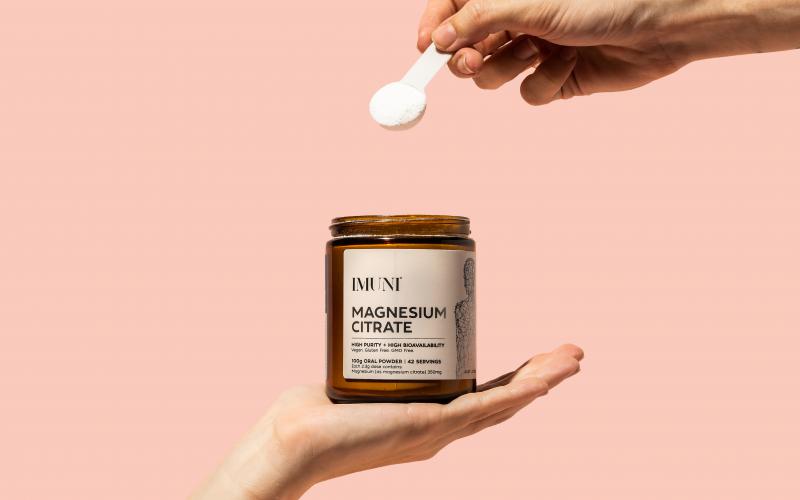How much magnesium do we need?

In Australia, data from the Australian Bureau of Statistics suggests that one in three Australians over the age of two do not meet their Estimated Average Requirement (EAR) for daily intake of magnesium (37% of males and 34% of females do not meet this requirement).
The same national survey also revealed that 72% of teenage girls and 61% of teenage boys (ages 14 to 18) did not meet the EAR.3 Inadequate intake of magnesium may impair biochemical processes that are specifically dependent on this important mineral.
Several factors may contribute to suboptimal magnesium intake and deficiency states: (2)
- The main cause of magnesium deficiency is chronic low intake from dietary sources
- Lower levels of magnesium are found in processed foods and some non-organic foods
- Magnesium-deplete foods including meat, sugar and flour comprise a significant portion of conventional diets.
- Heating processes such as cooking and boiling can result in significant decline in magnesium content
- Vitamin D deficiency is common and may cause a reduction in the absorption of gastrointestinal magnesium
- Certain medications, such as antibiotics, antacids and hypertensive drugs can diminish the absorption of magnesium
- Cigarette smoking reduces plasma magnesium concentrations
- The absorption of magnesium may decline with age by as much as 30%
The importance of Magnesium
Magnesium (Mg) is the fourth most abundant mineral in the human body, after calcium, sodium and potassium and the second most common intracellular cation after potassium. Magnesium is an important mineral that plays a role in over 300 enzymatic reactions in the body.
Magnesium serves critical roles in muscle and nerve function, blood sugar control, bone health and protein synthesis. It is necessary for the transmission of nerve impulses, muscular activity and for the formation of healthy bones and teeth. When there is suboptimal intake of magnesium, it can compromise cellular activity, especially in the tissues of the heart, nerves and kidneys. (1,2)
Over the last 30 to 40 years, magnesium intake has declined in multiple industrialised countries due to behavioural changes in the way societies consume and prepare food. Evidence suggests that nearly two-thirds of the population in the western world is not reaching the recommended daily intakes for magnesium. (2)
What are reliable sources of magnesium?
Sufficient intake of magnesium can be obtained with an adequately planned diet or by using a high-quality health supplement. Foods that are rich in magnesium include green leafy vegetables, legumes, nuts, seeds and whole grains.
Oral supplements may contain several different forms of magnesium and the chemical properties of the various forms will affect their efficiency in terms of absorption and bioavailability. Magnesium citrate, aspartate, lactate and chloride forms are more water-soluble and are therefore absorbed more completely with greater bioavailability than other forms such as magnesium oxide and magnesium sulfate. (4,5)
How much magnesium do we need?
Adults: the current Estimated Average Requirement (EAR) for Australian adults is 350mg/day for men and 265mg/day for women with the Recommended Dietary Intake (RDI) faring a little higher at 420mg/day for men and 320mg/day for women.
Pregnant and breastfeeding women over the age of 18 need approximately 350-360 mg a day (depending on age).
Recommended dietary intake (RDI) for children:
- 12-13 years old: 240 mg
- Boys aged 14-18 years old: 410 mg
- Girls aged 14-18 years old: 360 mg
The National Health and Medical Research Council (NHMRC) has set the recommended upper level of intake (UL) for magnesium at 350 mg/day. Avoiding intake of supplementary magnesium above this dose will help to prevent adverse gastrointestinal side effects in most individuals. Diarrhoea is usually the first sign of excess intake. (4)
IMUNI Magnesium Citrate is a premium, high purity formula that helps maintain healthy levels of magnesium in the body and helps prevent magnesium deficiency. Magnesium citrate is a highly bioavailable form of magnesium.
References:
Magnesium. Fact Sheet for Health Professionals. National Institutes of Health. Office of Dietary Supplements. [cited 06 Dec 2021]. Available from: https://ods.od.nih.gov/factsheets/Magnesium-HealthProfessional/
Schwalfenberg G & Genuis S. 2017. The importance of magnesium in clinical healthcare. Scientifica. Article ID 4179326. Available from: https://www.hindawi.com/journals/scientifica/2017/4179326/
Australian Health Survey: Usual Nutrient Intakes, 2011-12 financial year [Internet]. Australian Bureau of Statistics. 2021 [cited 13 Dec 2021].
Magnesium. Nutrient Reference Values for Australia and New Zealand. National health and medical research council (NHMRC). [cited 13 Dec 2021]. Available from: https://www.nrv.gov.au/nutrients/magnesium
Kappeler D et al. 2017. Higher bioavailability of magnesium citrate as compared to magnesium oxide shown by evaluation of urinary excretion and serum levels after single-dose administration in a randomised cross-over study. BMC Nutrition. 3(7). Available from: https://bmcmutr.biomedcentral.com/articles/10.1186/s40795-016-0121-3
The information presented in this article is intended to be general in nature. Always seek medical advice from your qualified practitioner before using any supplements or following any information presented.







